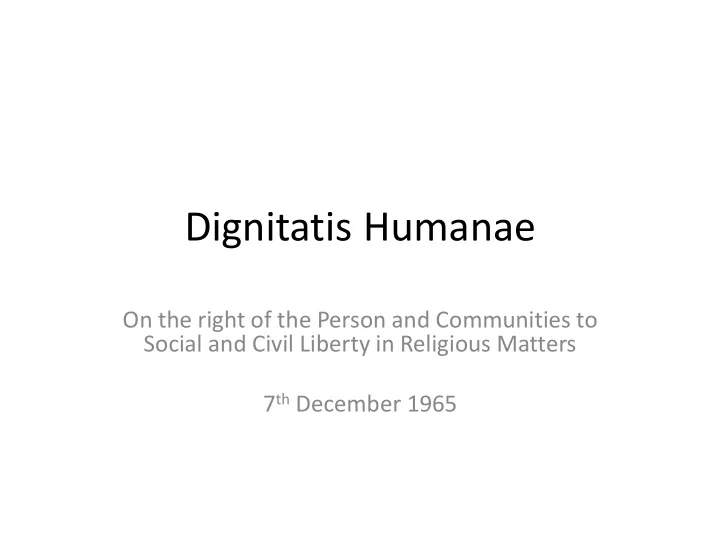

Dignitatis Humanae On the right of the Person and Communities to Social and Civil Liberty in Religious Matters 7 th December 1965
Gregory XVI "liberty of conscience and worship is each man's personal right, which ought to be legally proclaimed and asserted in every rightly constituted society; and that a right resides in the citizens to an absolute liberty, which should be restrained by no authority whether ecclesial or civil, whereby they may be able openly and publicly to manifest and declare any of their ideas whatever, either by word of mouth, by the press, or in any other way." (quoted by Pius IX, Quanta Cura) INSANITY!
Gregory XVI “This shameful font of indifferentism gives rise to that absurd and erroneous proposition which claims that liberty of conscience must be maintained for everyone”. (Mirari Vos)
“More and more people are demanding that men should exercise fully their own judgement and a responsible freedom in their actions and should not be subject to pressure of coercion but be inspired by a sense of duty” (1)
Outline of the Document 1. The role of conscience 2. The avoidance of coercion 3. The role of civil authority 4. The gentle and powerful preaching of the Gospel
Gravissimum Educationis Vatican II Declaration on Christian Education 28 th October 1985
Outline of the document 1 - The inalienable right to education 2 - Intended outcomes of education 3 - Parents as the primary educators of their children 4 - The primacy of catechetical instruction 5 - The role of the school and the teachers 6 - Support of parents in choice of school 7 - Attention given to those attending non-Catholic schools 8 - Roles within Catholic schools 9 - The range of educational institutions 10 - Higher Education 11 - The sacred sciences 12 - Cooperation
Gravissimum Educationis “The sacred ecumenical Council has given careful consideration to the paramount importance of education in the life of men” “What is at stake in the school is the salvation or ruin of every single soul” (Pope Pius XII)
“All men of whatever race, condition of age, in virtue of their dignity as human persons, have an inalienable right to education” (GE 1)
Why is there a document on education? • We are more conscious of our own dignity and responsibility. • Taking a more active role in social life. • Technology and social communication giving us more time. • More and more schools opening. • Methods of education are being developed.
Why is the Church getting involved? • “to fulfil the mandate she received from her divine founder” ( GE, Preface ) – “Go into the world and preach the gospel to the whole of creation” (Mark 16:15) – “to unite all things in him [Christ]” (Ephesians 1:10)
This education should be: • Suitable to the particular individual • Adapted to their ability, sex and national cultural traditions? • Conducive to fraternal relations with other nations in order to promote true unity and peace in the world
How should education act? • Weight given to psychological, pedagogical and intellectual sciences. • It should help develop the students physical, moral and intellectual qualities • They should gain a sense of responsibility through an understanding of and pursuit of liberty.
Situation of children • Radical Instability – One-dimensional universe of utility – Progressing beyond this narrow universe and desire to be released from it. • Uncertainty about their future • Enthusiasm about causes which lack inner coherence
However “In a Catholic school, as in any school, one can find young people who are outstanding in every way- in religious attitude, moral behaviour, and academic achievement” (Religious Dimension of Education in a Catholic School, 18) “When we look for the cause, we often discover an excellent family background reinforced by both Church and school”. (Religious Dimension of Education in a Catholic School, 18)
What makes a Catholic school distinctive? • The educational climate. • The personal development of each student. • The relationship established between culture and the Gospel. • The illumination of all knowledge with the light of faith
Marks of a Catholic School 1. Inspired by a supernatural vision 2. Founded on a Christian Anthropology 3. Animated by Communion and Community 4. Imbued with a Catholic world view 5. Emphasis on Faith and Reason
Current Questions • Freedom of conscience in work. • Proclaiming the Gospel in schools. • Recruitment of Catholic teachers. • Sex and Relationship Education.
Recommend
More recommend